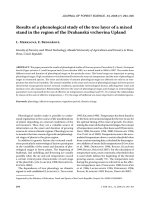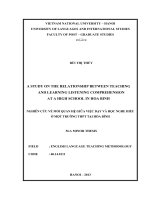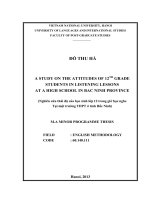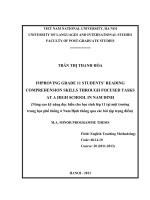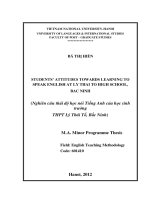A STUDY ON GRADE 10 TH STUDENTS’ PERCEPTIONS TOWARDS LEARNING TO READ ENGLISH AT A HIGH SCHOOL IN THE NORTH OF VIETNAM
Bạn đang xem bản rút gọn của tài liệu. Xem và tải ngay bản đầy đủ của tài liệu tại đây (973.36 KB, 63 trang )
VIETNAM NATIONAL UNIVERSITY, HANOI
UNIVERSITY OF LANGUAGES AND INTERNATIONAL STUDIES
FALCUTY OF POSTGRADUATE STUDIES
ĐỖ THỊ THÚY
A STUDY ON GRADE 10
TH
STUDENTS’ PERCEPTIONS
TOWARDS LEARNING TO READ ENGLISH AT A HIGH
SCHOOL IN THE NORTH OF VIETNAM
NGHIÊN CỨU NHẬN THỨC CỦA HỌC SINH LỚP 10 ĐỐI VỚI
VIỆC HỌC ĐỌC HIỂU TIẾNG ANH Ở MỘT TRƯỜNG THPT Ở
MIỀN BẮC VIỆT NAM
M.A. Minor Programme Thesis
Field: English Teaching Methodology
Code: 60140111
HANOI–2014
VIETNAM NATIONAL UNIVERSITY, HANOI
UNIVERSITY OF LANGUAGES AND INTERNATIONAL STUDIES
FALCUTY OF POSTGRADUATE STUDIES
ĐỖ THỊ THÚY
A STUDY ON GRADE 10
TH
STUDENTS’ PERCEPTIONS
TOWARDS LEARNING TO READ ENGLISH AT A HIGH
SCHOOL IN THE NORTH OF VIETNAM
NGHIÊN CỨU NHẬN THỨC CỦA HỌC SINH LỚP 10 ĐỐI VỚI
VIỆC HỌC ĐỌC HIỂU TIẾNG ANH Ở MỘT TRƯỜNG THPTỞ
MIỀN BẮC VIỆT NAM
M. A. Minor Programme Thesis
Field: English Teaching Methodology
Code: 60140111
Supervisor: Hoàng Thị Hạnh, PhD
HANOI – 2014
i
DECLARATION
I certify that all the material in this study which is not my own work has been
identified and acknowledged, and that no material is included for which a degree
has already been conferred upon me.
Hanoi, September, 2014
Đỗ Thị Thúy
ii
ACKNOWLEDGEMENT
First of all, I would like to express my deep gratitude to my supervisor, Mrs
Hoàng Thị Hạnh, for giving effective instructions and invaluable advice during the
preparation and completion of this graduation paper.
I also wish to acknowledge my debt to all the teachers of Faculty of
Postgraduate Studies at Vietnam National University, Hanoi – University of
Languages and International Studies, whose lectures and ideas have inspired my
thesis.
My appreciation also goes to the teachers and students at Hai Hau A high
school for their valuable assistance in completing my survey questionnaire and
interview, and providing me with a lot of useful information.
Finally, I would like to send my great thanks to my family, my friends who
have directly or indirectly helped me with their encouragement and advice.
iii
ABSTRACT
Pleasure reading has greatly affected reading achievements. There have been
some studies investigating students‟ pleasure reading habits and their attitudes
towards reading in English such as Camiciottoli (2001); Ro and Chen (2014).
However, few are found investigating high school students in the context of
Vietnam. Therefore, this study will focus on high school students‟ pleasure reading
habits and their attitudes towards reading in English. A set of survey questionnaire
and interview are used to explore the 10
th
students‟ pleasure reading frequency and
their attitudes towards reading in English for pleasure at a high school in the North
of Vietnam. Besides, factors that may have influenced pleasure reading and
students‟ attitudes are also examined. The findings show that most students do not
have good reading habits, and “lack of time” is the reason limiting their reading.
The study also finds out that reading frequency and students‟ attitude have strongly
positive relationship. In addition, “past access of English books” and “L1 reading
habits” are correlated with pleasure reading frequency and students‟ attitude
towards reading in English. The recommendations, limitations and suggestions for
further studies are mentioned carefully in this study.
iv
TABLE OF CONTENTS
DECLARATION i
ACKNOWLEDGEMENT ii
ABSTRACT iii
LIST OF ABBREVIATIONS vi
LIST OF TABLES vii
LIST OF GRAPHS viii
PART A: INTRODUCTION 1
1. Rationale 1
2. Scope of the study 2
3. Aims of the study 2
4. Research questions 2
5. Methods of the study 3
6. Significance of the study 3
7. Structure of the report 3
PART B: THE BODY 5
Chapter 1: Literature review 5
1.1 Extensive reading and pleasure reading 5
1.1.1 Reading 5
1.1.2 Extensive reading 5
1.1.3 Pleasure reading 7
1.2 Pleasure reading habits 9
1.3 Reading attitudes 10
Chapter 2: The study 13
2.1 Setting 13
2.2 Participants 13
2.3 Instruments 14
2.4 Procedures 16
v
Chapter 3: Data analysis and findings 17
3.1 Coding and Analysis 17
3.2 Results 19
Part C: Discussion/Conclusion 31
1. Summary of major findings 31
2. Pedagogical implications 33
3. Limitations and recommendations for further studies 35
References 36
Appendix A …………………………………………………………… …….I
Appendix B V
Appendix C IX
vi
LIST OF ABBREVIATIONS
L1: First Language
L2: Second Language
ER: Extensive Reading
ESL: English as Second Language
EFL: English as Foreign Language
CEP: Community English Program
JFL: Japanese as Foreign Language
vii
LIST OFTABLES
Table 3.1: Pleasure Reading Frequency in English
Table 3.2: Types of Reading Materials
Table 3.3: Number of Books Read in the last 12 Months
Table 3.4:Reasons Limiting Pleasure Reading Frequency in English
Table 3.5: Ranking of Reasons Limiting Pleasure Reading Frequency in English
Table 3.6:Reasons for Reading in English for Pleasure
Table 3.7: Ranking Reasons for Reading in English for Pleasure
Table 3.8: Reasons Why Reading in English for Pleasure Important
Table 3.9: Gender and Frequency of English Pleasure Reading
Table 3.10: Gender and Attitude towards Pleasure Reading in English
Table 3.11: Factors that may have influenced on Pleasure Reading Habit and their
Attitudes (Pearson correlations (r))
viii
LIST OF GRAPHS
Figure 3.1: Pleasure reading habit and preference scores
Figure 3.2: Reading attitudes scores
Figure 3.3: Reading habits and attitudes relationship
1
PART A: INTRODUCTION
1. Rationale
Reading is one of the essential skills in learning and teaching English as a second
language (ESL) or a foreign language (EFL). Carrel (1988, p. 1) has found out that
for ESL and EFL students, reading may be the most important of the four skills to
master: “for many students, reading is by far the most importance of the four macro
skills, particularly in English as a second or a foreign language”. However, it seems
that many learners are not aware of this importance. Consequently, their reading
achievement is not high. In fact, there are many factors affecting reading results,
two of them are pleasure reading habits and attitudes towards reading. The study by
Robb and Kano (2013) show that 84% of students with pleasure reading get higher
score on reading tests than those without. Another study by Beglar, Hunt and Kite
(2012) find that the large amount of pleasure reading could lead to significant
reading rate gains. Thus, it is evident that pleasure reading greatly affects reading
achievement. In addition, many studies have also presented that attitudes towards
reading have a great influence on reading achievements (Kamhi-Stein, 2003;
Yamashita, 2004, 2007, 2013). According to Yamashita (2013) reading attitude
may foster intrinsic motivation (p. 258), and attitude is one of the factors that
influence the decision to read (p. 249). Thus, it is difficult to deny the important
role of pleasure reading and attitudes towards reading in general, and reading in
English in particular.
There have been some studies investigating students‟ pleasure reading habits and
their attitudes towards reading in English such as Camiciottoli (2001); Ro and Chen
(2014). However, their subjects are university students, and few are found
investigating high school students especially in the context of Vietnam. Therefore,
this study focuses on high school students‟ pleasure reading habits and their
attitudes towards reading in English. The findings are compared with current
2
literature. It is hoped that this study reveals issues concerning students‟ pleasure
reading habits and their attitudes towards reading in English in order that the
researcher can give more help for her students to encourage them to read more or
develop their reading habits. Besides, some recommendations are given to other
teachers to help students to facilitate their reading.
2. Scope of the study
Reading is a broad issue, so it is difficult to entirely discuss the matter in a minor
thesis. Therefore, this study only focuses on students‟ pleasure reading habits and
their attitudes towards reading in English, and factors affecting their reading
frequency and attitudes.
The subject under this research is 100 grade 10 students from a high school in the
North of Vietnam.
3. Aims of the study
In general, this study is designed to find out high school students‟ pleasure reading
habits and their attitudes towards reading in English.
To be specific, the research aims at:
- Investigating students‟ pleasure reading habits.
- Exploring students‟ attitudes towards reading in English
- Finding out factors affecting students‟ pleasure reading frequency and
attitudes.
4. Research questions
The study aims to answer the following questions:
1. How frequently do grade 10
th
students read in English for pleasure?
2. What are the students‟ attitudes toward reading in English?
3
3. Which factors may have influenced the students‟ pleasure reading frequency and
attitude?
5. Methods of the study
In order to find out the answers to three above questions, a survey research is
conducted. A questionnaire and a semi-structured interview are used to collect data.
The questionnaire, which is adapted from Ro and Chen‟s one (2014), consists of 17
questions. The semi-structured interview is used in order to deeper understand
information from questionnaire.
6. Significance of the study
This study focuses on finding out students‟ pleasure reading habits and their
attitudes towards reading in English. Additionally, factors affecting students‟
reading frequency and attitudes towards reading in English will also be revealed.
Moreover, the findings of this research are thought to be useful for teachers to help
students during reading process. Specifically, the results on students‟ pleasure
reading habits and their attitudes towards reading in English in this study will be
used to help the researcher improve her teaching in the future. Besides, she is able
to encourage her students to read more and enjoy reading.
7. Structure of the report
The paper is divided into three parts as follows:
Part A: Introduction - provides readers with rationale, aims, research questions,
significance, scope, methods and structure of the study.
Part B: Body- consists of three chapters.
Chapter 1: Literature review - presents the theoretical background for the
research and gives definitions of some key words in the study.
4
Chapter 2: The study - describe the methodology of the study. This includes
the setting, the participants, the research instruments and procedures used in this
study.
Chapter 3: Data analysis and findings - describes and analyse the finding from
the students‟ questionnaire and interview.
Part C: Discussion/ Conclusion – gives a summary of the whole study, its
pedagogical implication for teachers, limitations of the study and some
recommendations for further research.
5
PART B: THE BODY
Chapter 1: Literature review
This chapter provides readers with theoretical background of the study and critical
review of previous related studies.
1.1 Extensive reading and pleasure reading
1.1.1 Reading
Reading is an important instrument providing human beings with a lot of
information which helps to build their understanding of life or worldview. Clark
and Rumbold (2006, p. 5) state that in addition to personal and mental
developments, reading is critical for ensuring one‟s access to social, economic
and civic life. Obviously, each person reads for his or her own purposes. A study
by the Nestle Family Monitor (2003) shows that 55% of young people read to
understand different people/cultures, 40% to learn more about new subjects, and
33% to try new hobbies. When asked how they would describe reading, half of the
respondents describe it as relaxing while a third finds it funny. Two in five also
consider reading as educational, while a quarter believed it to be informative for
learning (Nestle Family Monitor, 2003 as cited in Clark & Rumbold, 2009, p. 9).
1.1.2 Extensive reading
Based on purposes of reading, Nuttall (2005, p. 38) classifies reading into two main
types: intensive and extensive reading (ER). There have been many studies
reporting positive effects of ER on a range of EFL and ESL contexts. The positive
effects have been seen in areas such as reading comprehension (Bell, 2001;
Yamashita, 2008; Taylor, 2014), reading rate (Beglar, Hunt & Kite, 2012; Fujita &
Noro, 2009; Matsui & Noro, 2010), vocabulary (Pigada & Schmitt, 2006;
Poulshock, 2010), grammar (Yang, 2001), L2 proficiency (Iwahori, 2008). There
6
also is evidence that ER has positive impacts on the affective domains of reading,
such as attitude and motivation (Grabe, 2009). Taylor (2014, p. 196) concludes that
those with extensive reading perform higher on tests of reading comprehension
than those without. Additionally, Anderson (2008, p. 67) affirms that extensive
reading has a consistently beneficial effect on reading rate development, especially
for students at low reading proficiency levels. Beglar, Hunt, and Kite (2012) find
the same result that is reading rates of Japanese university studentswho read books
for pleasure increased greater than reading rates of those reading intensively.
Additionally, ER (extensive reading) has been shown to increase learners‟ positive
attitude toward reading (Karlin & Romanko, 2008). Therefore, understanding and
applying ER is necessary for EFL students.
There have been many definitions of ER. Waring & Takahashi (2000, p. 6) define
ER classrooms: students read a “huge amount of very simple text so that [they]
can read smoothly, confidently and pleasurably”. Extensive reading is an approach
to teaching and learning reading that uses reading materials that are
understandable and meaningful to the learner in order for learners to be able to
read large amounts. The aim of ER is improvement in reading ability, fluency, and
enjoyment (Krashen, 2011). Another definition by Grabe & Stoller (2011) was that
ER is an approach to reading pedagogy that encourages students to engage in a
large amount of reading. Sharing the same opinion, Richards & Schmidt (2002, p.
193–194) stated that ER “means reading in quantity and in order to gain a general
understanding of what is read. It is intended to develop good reading habits, to
build up knowledge of vocabulary and structure, and to encourage a liking for
reading”. It can be seen that each author viewed ER at different aspects, but they
shared some features. The first is that extensive reading is generally associated
with reading large amounts or long texts on the purpose of getting an overall
understanding of the material. The second is readers often use this kind of reading
to find out the meaning of the whole text rather the meaning of individual words or
7
sentences. The last one is extensive reading provides students opportunities to
update and enrich their knowledge by reading the topics they like for enjoyment
without consideration for pressure of time. Therefore, extensive reading is
regarded as an effective way for the students to improve their reading skills and
increase their general knowledge as well.
1.1.3 Pleasure reading
Sometimes, ER is referred to alternative terms such as pleasure reading, sustained
silent reading, free voluntary reading or book flood (Richards & Schmidt, 2002, p.
193–194). However, to some extents, pleasure reading and extensive reading are
not completely the same. Maley (2008) states the purposes of ER that are for
pleasure, information and general understanding. It means that in addition to
pleasure, readers learn, analyze, question and think about something during their
extensive reading. In contrast, when someone reads for pleasure, he or she reads for
fun to relax and enjoy. Obviously, they are different but connected things.
Sometimes, readers can even read for both meaning and pleasure. They may read a
book and analyze it but find as well that what they are reading is quite enjoyable.
Finding the difference between two terms, the researcher will apply the term
“pleasure reading” in this paper because it describes the type of reading that the
participants in this study engaged in. Besides, this study aims at exploring students‟
reading habits in leisure time, so it would be better to use the term “pleasure
reading”.
According to Nell (1988), reading for pleasure is a form of play that allows us to
experience other worlds and roles in our imagination. However, Pullman (2004)
argues that reading for pleasure is so much more than just a form of play or
escapism – it is also a way of connecting with text. Both of them agree that reading
for pleasure refers to reading that readers do in their own free time. They begins
reading not because of someone else‟s request but because they are interested in it.
8
It typically involves materials that reflect their own choice, at a time and place that
suits them.
Some of studies emphasize the importance of reading for pleasure for both
educational as well as personal development. Reading enjoyment plays an
important role in children‟s educational success. It is supported by Krashen (1993,
p. 85). He explores that when children read for pleasure, it acquires nearly all of the
so-called “language skills”: vocabulary, grammatical constructions, writing style.
However, he adds that pleasure reading alone though would not ensure attainment
of the highest levels of literacy; it will at least ensure an acceptable level. Without
it, children may simply do not have a chance to acquire necessary skills to reach
acceptable level in language. Additionally, there is also evidence that reading for
pleasure not only impacts reading achievement but also increases general
knowledge (Cunningham and Stanovich, 1998), understanding of other cultures
(Meek, 1991), and a greater insight into human nature and decision-making
(Bruner, 1996). Moreover, reading for leisure can also promote or enhance social
skills in children (Allan, Ellis & Pearson, 2005). Overall, when individuals read for
pleasure frequently, “they experience the value of reading as efferent and aesthetic
processes. Thus, they are more likely to read with a sense of purpose, which further
supports their developing reading habit. (Sanacore, 2002, p. 68)
In conclusion, this part has presented some information on reading, extensive
reading, pleasure reading and their roles. Reading is not only an essential tool to
achieve knowledge but it is an means of relaxing. There has been evidence that
extensive reading and pleasure reading have influence on reading achievement.
Therefore, it is necessary to encourage students to apply these two forms of
reading.
9
1.2 Pleasure reading habits
The concept of reading habit is defined as “how often, how well, and what adults
like to read” (Scales & Rhee, 2001, p. 178). It means that reading habit is
measured by how frequently readers read, whether they read entire books, and what
they like to read. It refers to people‟s reading activities and how frequently they
engage in reading them (frequency of engagement). The benefits of reading in
general and pleasure reading in particular have been stated. In some countries,
however, there is evidence that reading habits have declined. A UK survey by
Sainsbury and Schagen (2004) indicates that children‟s reading enjoyment has
declined significantly in the last five years, especially amongst older children. The
study shows that the percentage of engaged readers has decreased from 77% to
71% among Year 4 pupils and from 77% to 65% amongst Year 6 pupils between
1998 and 2003. Additionally, reading habit of students in Social Sciences and Arts
at Rajshahi university have been declined (Eamin Ali Akanda, Hoq & Hasan,
2013).These researchers state that this decline is most noticeable among young
people because they are the people who are most affected by the emerging
digital technologies, especially the Internet and TV-based entertainment. Another
study carried out by Camiciottoli (2001) on Italian university EFL students‟ habits
and attitudes towards extensive reading found that “positive attitude + low
frequency” was the most common reading profile, accounting for 41.8% of the
respondents. It means that most of participants in this study did not have good
reading habits. In contrast, the result of a study by Ro and Chen (2014) on
advanced non-academic English-as-a-second-language learners in the US not only
shows that the participants had good reading habits, but also reveals that they read
more English books for pleasure than the participants in the one by Camiciottoli
(2001) . However, when investigated factors affecting reading habits, both these
studies agree that lack of time was the most selected reasons for poor reading
habits. Besides, other studies showed that there are some other factors that
10
influence reading habits such as age, gender, educational level, reading level
(Mellard, Patterson, & Prewett, 2007; Scales & Rhee, 2001). The studies above,
therefore, indicate that, generally, multiple factors may play a crucial role in the
creation of reading habits. Research has also found that an important factor in the
development of a reading habit is a positive attitude towards reading (Kim, 2003;
Camiciottoli, 2001; Ro & Chen, 2014).
1.3 Reading attitudes
Attitude is a complex psychological construct. It refers to “a learned predisposition
to respond in a consistently favorable or unfavorable manner with respect to a
given object” (McKenna, 1994). Reading attitude has been defined as “a system of
feelings related to reading which causes the learner to approach or avoid a reading
situation” (Alexander & Filler, 1976, p. 1) and as “a state of mind, accompanied by
feelings and emotions, which makes reading more or less probable” (Smith, 1990,
p. 215). According to an extensive and in-depth review of literature by Reeves
(2002), there is considerable agreement among contemporary researchers that
reading attitude is defined by three components: cognitive (personal, evaluative
beliefs), affective (feelings and emotions), and conative (action readiness and
behavioral intentions). Cognitive component shows our thoughts, beliefs, and ideas
about reading. For example: “I believe reading is useful for our brain“. .Affective
component, on the other hand, shows feelings or emotions about reading (e.g. fear,
sympathy, hate). For instance: “I like reading in English for pleasure”. The last
component is conative or behavioral one which shows the way the attitude we have
influences how we act or behave. For example: “I will read in English more in my
leisure time”.
Various studies on reading attitudes have been carried out (Camiciottoli, 2001;
Mori, 2002; Kamhi-Stein, 2003; Yamashita, 2004, 2007). These studies have
consistently found that reading attitude is one of the factors that influence the
11
decision to read, and it greatly affects the reading achievement and performance of
second language (L2) learners. Specifically, Kamhi-Stein (2003) uses in-depth
qualitative analysis to explore four L2 college students‟ attitudes towards their
home language and beliefs about reading. She also finds that her participants‟
attitudes towards L1 and beliefs about reading affect reading processes in both L1
and L2. To be more specific, those who valued L1 used it in the process of
decoding the L2 text. Moreover, Yamashita (2004, 2007) gives evidence to show
the close relationship between Japanese college students‟ attitudes and their L2
proficiency in an EFL setting. The questionnaire items measures both affective
(i.e., feeling) and cognitive (i.e., evaluative beliefs) reactions to reading. In
Yamashita (2007) she finds that positive L1 reading attitude would likely lead the
learners, even low proficiency ones, to read in L2. While L2 proficiency has very
little effect on the transfer of reading attitude, L1 reading attitude had strong impact
on L2 reading. In her previous paper (Yamashita, 2004), she provides four sub-
components of reading attitudes including comfort, anxiety, value ascribed to
reading, and self-perception as a reader and argues that comfort with reading and
positive self-perception as a reader in both L1 and L2 had positive impact on the
learners‟amount of EFL reading while anxiety and value had no influence at all.
However, Camiciottoli (2001) argues that mere attitudes of being positive do not
guarantee frequent reading. Based on her findings, Ro and Chen (2014) carry out a
replicated study on nonacademic students in an English-as-a-second-language
(ESL) setting in order to investigate whether learners‟ positive attitudes towards L2
reading can lead to higher reading frequency (i.e., higher amount of reading).
Unlike Camiciottoli‟s result, they find that the participants with positive attitudes
towards reading tend to read more. They also mention that lack of time was the
most selected reasons for poor reading habits.
The importance of reading in learning process as well as the role of pleasure
reading habits and reading attitudes towards reading and others skills has been
12
presented. It is clearly seen that most of studies have been carried out in EFL or
ESL contexts with university student participants. It is a big gap if there is not a
study on high school students‟ pleasure reading. Therefore, the researcher will
implement study on high school students‟ pleasure reading habits and their attitudes
towards reading in English in the context of Vietnam. The current study is a
replicated one of Camiciottoli (2001) carried out in Italy with non-academic ESL
learners and Ro and Chen (2014) done in the US with academic EFL students. The
findings will be compared with non-academic ESL learners‟ reading habits and
attitudes, and with academic students‟ reading habits and attitudes in an EFL
context.
13
Chapter 2: The study
This chapter describes the methodology of the study. This includes the setting, the
participants, the research instruments and procedures used in this study.
2.1 Setting
The study was carried out at a high school in the North of Vietnam. This school
was established in 1960. Now it has 42 classes in total. There are 45 to 50 students
in each class. The facilities in this school are not well-equipped. Although it has a
multimedia room with a TV, CDs, cassette players and projectors, it is only used on
special occasions. There is a library which provides a lot of reference books,
newspaper, magazines. However, materials in English are not various enough.
There are only some dictionaries and some books on grammar; thus, students
cannot access varied books for their English learning. In terms of teaching and
learning curriculum, the school follows the national one. For English, Basic
English textbooks are taught at this school. Grade 10
th
students are studying a book
with 16 units on different topics. Each unit is divided into 5 parts: reading,
speaking, writing, listening and language focus. Students attend three English
lessons per week.
2.2 Participants
Unlike two previous studies by Ro and Chen (2014) and Camiciottoli (2001) which
were conducted with non-academic ESL students at advanced level and EFL
university students respectively, the participants in this study were 81 grade 10
students (45 females,36 males) from two classes. All of them were born in 1998
and live in communes around the school. Their English levels are at pre-
intermediate level. They learn English as a foreign language and do not have
English environment to practice using English.
14
2.3 Instruments
If Camiciottoli (2001) used a 22-item questionnaire and Ro and Chen (2014)
designed a 23-item one to collect data on reading frequency and attitude, the study
only used a 17-item questionnaire to investigate students‟ pleasure reading habits
and attitudes towards reading in English. Besides, an interview with students was
also implemented to have deeper understanding about information collected from
questionnaire.
The questionnaire was written in Vietnamese to ensure that all participants fully
understood the questions. Like the two original studies (Camiciottoli, 2001; Ro &
Chen, 2014), the survey questionnaire was divided into three parts. Part 1 consists
of 6 items explored general information: gender (item 1), past access to English
books (item 2), encouragement from others to read in English for pleasure (item 3),
self-perception of reading ability in English (items 4-5), and purposes of learning
English (item 6). These are some contributing factors that may affect students‟
pleasure reading habit and attitude. Part 2 consists of 5 items which tried to
investigate reading habits: frequency and preference. Specifically, items 7 and 8
took information on frequency of reading books in one‟s native language, and items
9 to 11 on frequency of reading in English (reading volume and types of materials).
Part 3 asked about learners‟ desire to read more, their readiness to read in English
and opinions towards the importance of reading in English for leisure.
In order to have a study which suited to the current context, the researcher adapted
Ro and Chen„s questionnaire (2014) by adding, modifying and deleting the
following question items:
15
Addition: purpose of studying English (item 6)
Modification: reasons why reading English for pleasure (item 13)
Deletion: Name (item 1), nationality (item 3), age (item 4), years of studying
English (item 5), past attendance in extra classes (item 6), and time staying in
English native country (item 11) and purposes of staying in English native country
(item 12).
First of all, the purpose of studying was added to suit to the current study. Each
participant has his/her own purpose of learning English, which may have influence
on their reading habits and attitudes. Secondly, item 13 asking about reasons of
pleasure reading was modified because the researcher found the similar options
were given, so she combined them and made it clear to her participants. Thirdly,
item about name was deleted due to ethical issue of research. Besides, because all
participants are from the same district, same age and years of studying English,
items asking about this information were deleted. Additionally, extra classes were
not allowed in the area where the study was carried out, so question related to this
private course was not relevant. Lastly, due to Vietnamese setting of the research,
items investigating time and purposes of staying in English native countries were
eliminated.
The study by Camiciottoli (2001) and Ro and Chen (2014) ask university-level
EFL instructors and CEP teachers about questionnaire items to gain construct
validity. This study also asked teacher at the high school where the research was
carried out to see if the adapted questionnaire was suitable to the participants and
the purposes of the study. Additionally, before delivering the survey questionnaire,
the researcher gave it to 10 students to make sure that they understood all the
questions.




